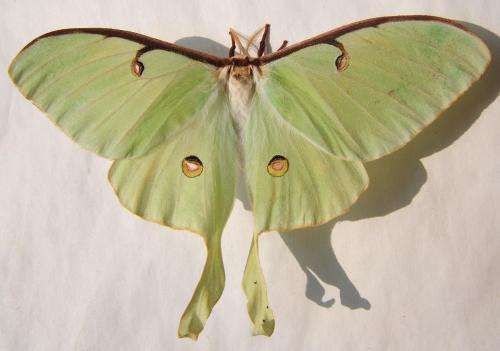Actias luna female. Credit: Wikipedia
(Phys.org)—A team of researches with members from several institutions in the U.S. has found that the long tails sported by the luna moth exist as a means to foil attacks by bats. In their paper published in Proceedings of the National Academy of Sciences, the team reports on experiments they conducted that confirmed the true purpose of the abnormally long tails in the moths.
Scientists have suggested for years that the extremely long luna moth tails were likely a defense mechanism of some sort, because it did not appear that they served any purpose in attracting a mate. In this new effort, the researchers sought to find the answer once and for all.
Suspecting the tail likely served as a way to confuse bats (their primary predator) the researchers gathered 162 of the moths and pulled the tails off 75 of them. They then tied them individually to a ceiling in a lab and then released a brown bat into the room to see how well the moths were able to ward off attacks. They found that the bats were able to catch 85 percent of the moths with no tails, but just 35 percent of those that still had theirs. This indicated, of course, that the tails helped to confuse the bats.
To better understand how exactly the tails helped the moths confuse the bats, the researchers filmed bat attacks on the moths using high speed cameras. They found that over half the time, the bats went for the tails, rather than the body, which often resulted in a miss, or a torn tail. They suspect that the swirling tail causes the echoing sounds emitted by the bats to be confused with those made by beating wings of other prey.
The researchers also compared the success rate of bats catching luna moths against a larger species of moth to see if perhaps the longer tails helped repel bats because it made the moths bigger. They found that being bigger did not help the moths escape the bats—thus it appears that it is all about mimicking the sound of wings beating. The team next plans to test other moths with long tails to see if their tails offer the same type of benefit.
Credit: PNAS, doi: 10.1073/pnas.1421926112
Credit: PNAS, doi: 10.1073/pnas.1421926112
More information: Moth tails divert bat attack: Evolution of acoustic deflection, by Jesse R. Barber et al. PNAS, www.pnas.org/cgi/doi/10.1073/pnas.1421926112
Journal information: Proceedings of the National Academy of Sciences
© 2015 Phys.org























